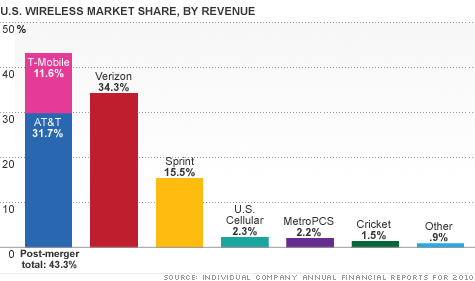Search News

NEW YORK (CNNMoney) -- In a response to the government's antitrust suit against its proposed merger with T-Mobile, AT&T issued a glowing report on the wireless industry's health -- with the sole exception of the carrier it is trying to buy.
"T-Mobile [is] the only major carrier to have actually lost subscribers in a robustly growing market," AT&T (T, Fortune 500) said in a court filing late Friday.
How accurate is that claim? As always in this merger deal, the reality is complicated.
The sentence is technically true, but only with a very narrow reading of "major," "subscriber," and "actually."
AT&T is correct in saying that among the four national carriers -- a group that also includes Verizon Wireless, AT&T and Sprint -- T-Mobile is the only carrier last quarter to have suffered a net loss in subscribers.
But not all customers are created equal. National carriers care most about customers under contract, because they provide a source of guaranteed revenue and tend to pay a lot more than prepaid customers.
In terms of customers under contract, Sprint (S, Fortune 500) has also been losing subscribers like crazy, shedding a net 101,000 last quarter. In fact, Sprint has lost net subscribers under contract in all but one quarter since the second quarter of 2007.
AT&T's statement also depends on its definition of "major," which the company seems to vacillate on.
In another part of its response to the DOJ, AT&T says it faces a fierce competitive environment on all fronts, from the biggest providers to the tiny regional carriers.
"The complaint largely ignores the significant competition from established providers such as Verizon Wireless and Sprint, innovative upstarts such as MetroPCS (PCS) and Leap/Cricket, and strong regional providers like US Cellular and Cellular South, among others," AT&T says of the DOJ's protest.
If those companies are real rivals, as AT&T claims, it's important to note that on a net basis, U.S. Cellular has lost customers for five straight quarters and Leap Wireless (LEAP) also shed more customers than it gained last quarter.
A spokesman for AT&T declined to comment for this story, saying he would let the filing "speak for itself."
But in that filing, AT&T appears to talk out of both sides of its mouth on multiple occasions.
In one part of its response, the carrier argued that the DOJ's "characterization of AT&T, T-Mobile, Verizon (VZ, Fortune 500), and Sprint as the 'Big Four' is misleading," because an FCC report recently showed that "more than 90% of U.S. consumers have at least five wireless providers to choose from." AT&T is claiming that it sees every rival as a genuine threat.
Yet AT&T also went out of its way to illustrate how T-Mobile is not a "material competitive constraint" on AT&T.
So how can AT&T claim that the regional and lower-cost carriers represent significant rivals if T-Mobile, the nation's fourth-largest wireless company, can't compete?
AT&T's rationalization relies on bifurcating the mobile market. It sees two viable playing fields -- big national player or low-cost regional carrier -- and no middle ground. T-Mobile's business model is unsustainably "stuck in the middle," AT&T says in its response to the DOJ.
But in its complaint, the DOJ said that it had reviewed several AT&T internal documents that seemed to show AT&T treating T-Mobile as a more significant challenger than regional players. For example, the DOJ cited a 2010 analysis -- identified only as an "AT&T internal document" -- describing T-Mobile's broadband network upgrades as a "more immediate threat" than other rivals', and one that "should be taken seriously."
In response, AT&T admonished the Justice Department, saying its use of "unidentified written material, without context, is misleading and inappropriate."
AT&T said it continues to fight for its merger with T-Mobile, both by pursuing an expedited court hearing and -- its preference -- a settlement with the DOJ that would let the deal go forward.
"If and when these discussions occur they will be confidential and as such we won't be commenting publicly," AT&T said. ![]()